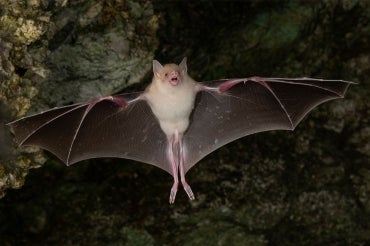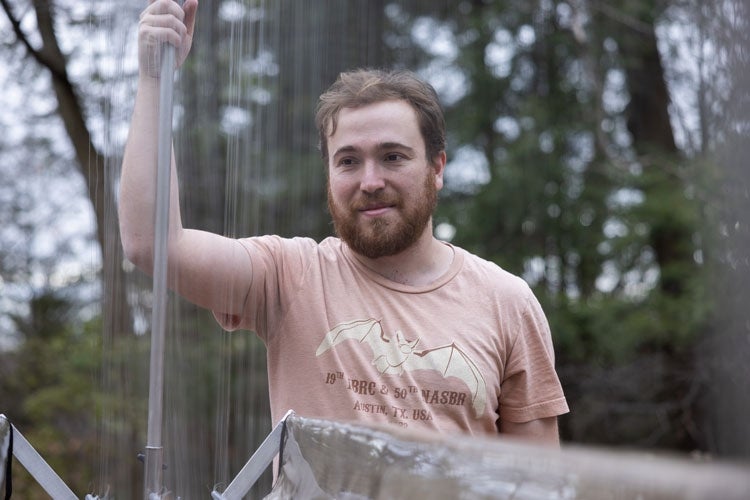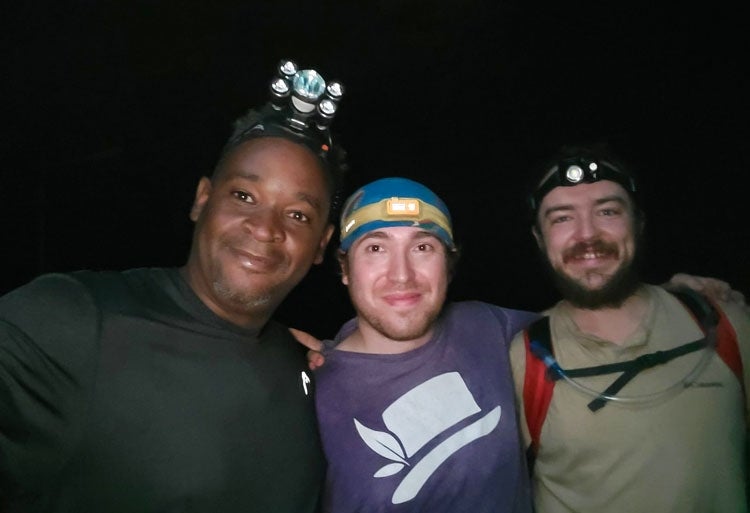U of T researcher discovers critically endangered bats in two new locations

Finding the Jamaican flower bat in two new locations is raising hope for the critically endangered species (photo by Sherri and Brock Fenton)
Published: January 23, 2024
The Jamaican flower bat is endangered – so much so that experts believed only a small colony of about 500 existed in a single cave.
But an international team of researchers, including a PhD student from the University of Toronto Scarborough, recently discovered two new locations where the bat lives.
Published in Oryx, the International Journal of Conservation, the research shows the bat living in Jamaica’s Green Grotto Caves and Rock Spring Caverns.
“It’s exciting that we found them in two new locations, but it doesn’t mean they still aren’t in danger of going extinct,” says Phillip Oelbaum, a PhD student in Associate Professor Ken Welch’s lab in the department of biological sciences and lead author of the study.
“It also doesn’t mean they should be delisted as a critically endangered species. It just shows how little we know about them and that more research is needed.”
Nobody knows why, exactly, there are so few Jamaican flower bats in existence. The bat is found only in Jamaica so it’s possible its numbers may have always been low. It may also be threatened due to habitat disturbance from bauxite mining, predation from cats and guano harvesting. Guano (bat feces) is a highly sought after fertilizer because of its high nitrogen and phosphorus content and is commonly used by farmers growing cannabis.
The species was declared extinct until 2010 when a small colony was found in Stony Hill Cave, so finding these new breeding grounds raises hope for its survival and conservation, Oelbaum says.
A chance discovery
In Jamaica doing research on nectar and fruit-eating bats, Oelbaum says the Jamaican flower bat was on his radar, but he didn’t have high hopes of finding them.
The first location, Green Grotto Cave, is a popular tourist destination on the north part of the island just outside Runaway Bay. The bats were discovered in a lower part of the cave system in what’s known as the wild caves, a spot that’s not accessible to tourists. Previous acoustic detection and photos hinted that Jamaican flower bats might live there, but finding pregnant females was definitely a “happy accident,” says Oelbaum.
He almost didn’t make it to Rock Spring, the second spot, located in St. Mary Parish in the north, central part of the Island. The van Oelbaum was travelling in with fellow researcher Ronnie Hall, a grad student at the University of California, Merced, and Stefan Stewart, an expat Canadian and experienced cave explorer with the Jamaican Caves Organisation, hit a series of deep potholes and nearly rolled down the side of a hill.
“It was a rough start, and if it wasn’t for the help of local residents at Rock Spring who helped us get back on the road, we wouldn’t have made it to the cave at all,” Oelbaum says.

Despite arriving at their destination late, they took Stewart’s advice and set their harp traps next to a giant sinkhole known as Big Hole. A harp trap is a device that uses a series of strings to disrupt a bat’s flight, letting them drop harmlessly into a collection chamber.
As the sky grew darker a large funnel of bats emerged from the cave in what Oelbaum describes as a “batnado,” and once the bats flew into the trap it was just a matter of picking them up to check the species. That’s when they came across a lot of Jamaican flower bats.
What distinguishes the Jamaican flower bat is a bright pink forearm and the fur found on its upper body is often blondish and short compared to the buffy flower bat, which it closely resembles. It also has a protruding bone (known as a calcar) found on the inner side of the ankle.
“Even their facial structure is unique. Once you have one in your hand, there’s no mistaking it’s a Jamaican flower bat,” says Oelbaum.

Next steps
Oelbaum is currently in Jamaica doing a survey of 30 locations with Damion Whyte, a PhD student at the University of the West Indies who was also an author on the study. They want to see if the Jamaican flower bat can be found at other locations.
The goal is to further study their habitat and behaviour since the bat is likely an important pollinator, and might also play a role in insect control and dispersing flower seeds. They also want to analyze hair and skin samples to better understand its diet.
“Damion is from Jamaica and has been instrumental in this research,” says Oelbaum. “I’m excited to see what else we can come up with and hopefully shed more light on this elusive bat.”



